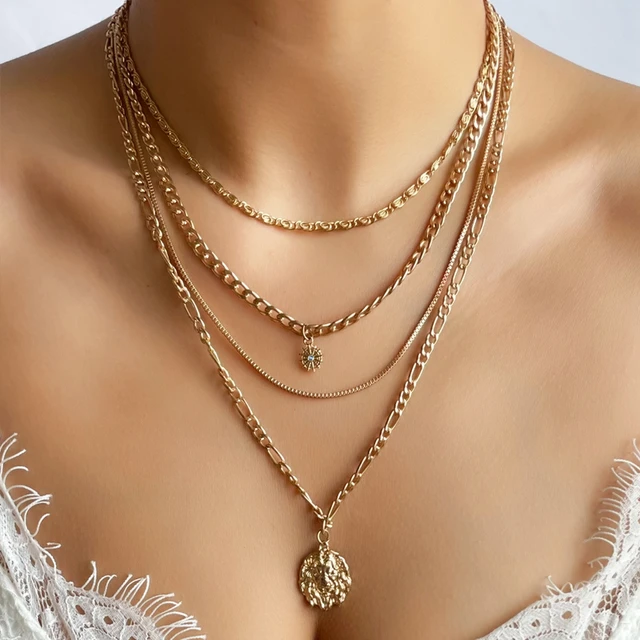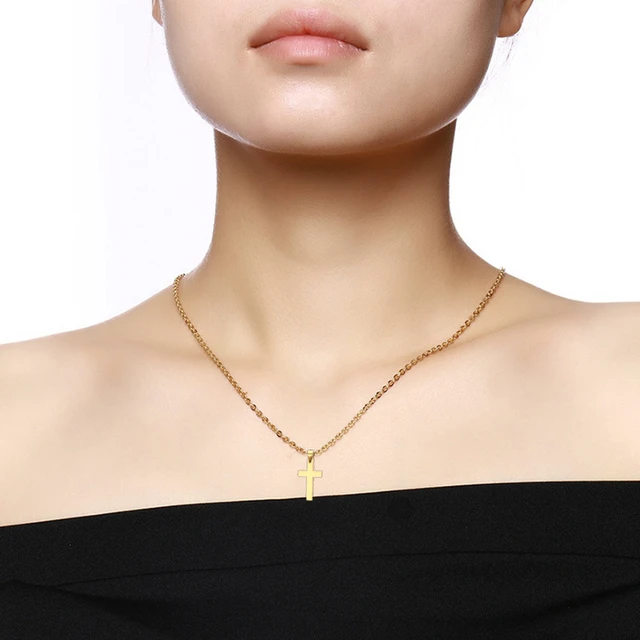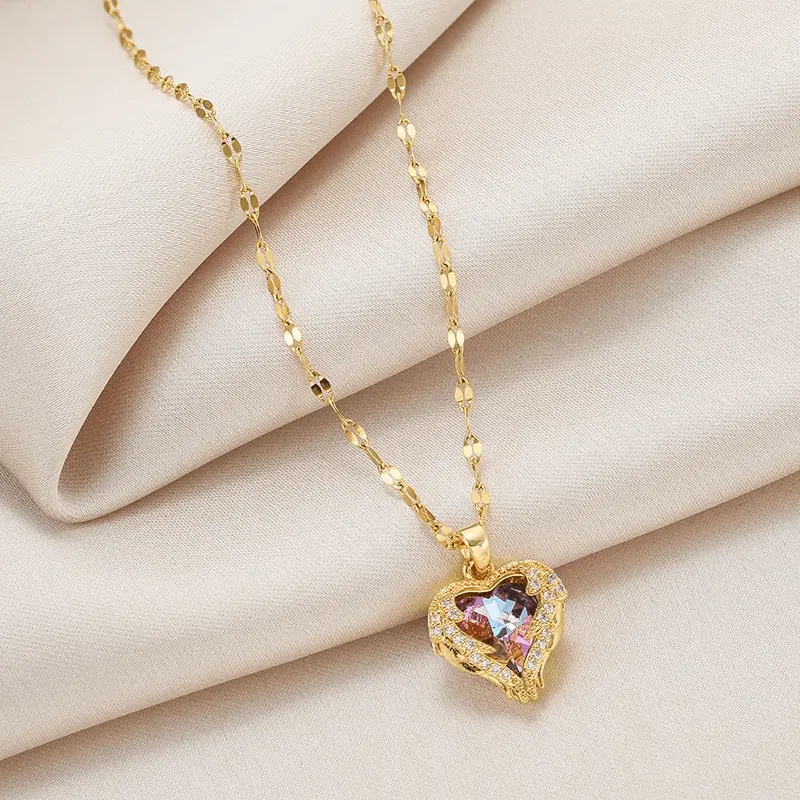
Layering gold necklaces is an art that can transform a simple outfit into a fashion-forward statement.
Here’s how to create an on-trend layered necklace look:
Choose Different Lengths:
The key to layering necklaces successfully is to vary the lengths. Start with a shortest chain, then add medium and longer chains.
A common and visually appealing sequence is having a choker (14-16 inches), a princess length necklace (18 inches), a matinee length (20-24 inches), and an opera or lariat length (30 inches or more).
This creates depth and dimension, preventing the necklaces from tangling and allowing each piece to stand out.
Mix Chain Styles:
Combine different types of chains like delicate cable chains, rope chains, box chains, and even statement pieces with larger links.
This variety adds visual interest and texture. Also, consider mixing up pendant sizes and styles – tiny pendants for a dainty look or bold geometric shapes for a contemporary edge.
Consider Color Gradient:
While all-gold looks cohesive, you can also play with different shades of gold such as rose gold, yellow gold, and white gold.
Arranging them in a gradient from lightest to darkest can be very stylish.
Add Personalization:
Incorporate personalized charms, initials, or birthstones into your layers. These not only personalize your style but also act as great conversation starters.
**Keep Symmetry in Mind: Symmetrical layering involves evenly spaced necklaces of varying lengths.
Asymmetric layering, however, breaks the rules by placing necklaces at random lengths and sides, which can create a more eclectic and playful vibe.
Balance Heaviness:
Balance heavier or chunkier pieces with lighter ones. If one necklace has a large pendant, balance it with smaller, simpler chains.
This prevents the ensemble from looking too heavy on one side.
Highlight Key Pieces:
Let one necklace be the focal point, perhaps a statement piece, while others serve as complements.
You could choose a standout pendant or a unique design and build your layers around it.
Casual vs Formal:
For casual wear, multiple thin chains or beads work well. For formal occasions, you might opt for fewer, yet more substantial chains, possibly including pearls or precious gemstones.
Consider Your Outfit:
Choose necklace lengths and styles that complement your neckline. V-neck tops and dresses are perfect for showcasing layers, while crewneck tops suit shorter chains or chokers.
Accessorize Further:
Don’t forget to coordinate your layered necklaces with earrings, bracelets, and rings.
Layering doesn’t just stop at necklaces; harmonizing your entire jewelry collection can elevate your overall look.
Remember, there are no hard and fast rules when it comes to layering necklaces—it’s about expressing your personal style and having fun with accessorizing. Experiment until you find a combination that feels right for you!

Gemstones pair beautifully with gold necklaces, adding a pop of color and enhancing the luxurious appeal.
Here are some gemstones that complement gold particularly well for women’s jewelry:
Diamonds:
Classic and timeless, diamonds sparkle against any shade of gold, from yellow to rose to white. They work for both formal and casual settings.
Sapphires:
Rich blue sapphires are regal when set in gold, but they also come in a variety of other colors such as pink, yellow, and green which can create stunning contrasts or harmonies with gold.
Rubies:
The deep red hue of rubies is intensified by the warmth of yellow gold, making them a captivating combination. Rubies also look elegant in rose gold, accentuating their pink undertones.
Emeralds:
The lush green of emeralds is a perfect match for yellow gold, creating an opulent vintage vibe. They also stand out against white gold for a more contemporary look.
Pearls:
Cultured or natural, pearls offer a classic sophistication when paired with gold. Their creamy luster complements all shades of gold and adds a touch of elegance to any ensemble.
Aquamarine:
With its serene blue-green tones, aquamarine looks refreshing against gold, especially during warmer months or for beach-themed jewelry.
Citrine:
This sunny, golden-yellow gemstone naturally complements yellow gold, while it offers a delightful contrast against white gold or rose gold.
Amethyst:
Deep purple amethysts provide a rich, royal contrast to gold, looking equally striking in both yellow and rose gold settings.
Tourmaline:
Available in a rainbow of hues, tourmalines like pink, green, and watermelon varieties can be creatively combined with different gold colors for a playful, colorful statement.
Topaz:
Blue topaz or imperial topaz (with its orange-pink tones) pairs nicely with gold, providing a bright, eye-catching focal point on a necklace.
Remember, personal style, occasion, and skin tone should all factor into your choice of gemstone and gold pairing.
Mixing and matching different gemstones in one necklace can also create a unique, eclectic piece.

White gold and rose gold necklaces, much like traditional yellow gold pieces, are indeed considered durable jewelry options, provided that the composition and karatage are taken into account.
The durability of a gold necklace is primarily determined by its karat purity, which reflects the amount of pure gold in the alloy.
Gold in its purest form (24K or 100% gold) is soft and malleable, making it less suitable for everyday wear due to its susceptibility to scratching, denting, and deforming.
To enhance strength and durability, gold is typically mixed with other metals to create an alloy. This process not only hardens the metal but also allows for a variety of colors.
White gold and rose gold are two such color variations that have gained immense popularity.
White Gold:
White gold alloys are created by combining pure gold with white metals, usually silver, palladium, nickel, or a combination of these.
Palladium is often used as a more hypoallergenic alternative to nickel since some people may have allergic reactions to nickel.
A common practice is to plate white gold jewelry with rhodium, a member of the platinum group metals, to give it a bright white sheen and further enhance its durability.
While the underlying white gold alloy contributes to the structural integrity of the piece, the rhodium plating can wear off over time, especially with frequent wear and exposure to chemicals like perfumes and lotions.
However, this does not affect the inherent durability of the white gold; it simply affects the appearance, necessitating periodic re-plating to maintain the white luster.
Rose Gold:
Rose gold, also known as pink or red gold, gets its characteristic hue from the addition of copper to the gold alloy. Sometimes, a small percentage of silver or zinc may be included too.
Copper is harder than gold, thus contributing to the overall strength of the alloy.
Rose gold jewelry is known for its romantic and vintage appeal, and because of the higher copper content, it tends to be slightly more durable than lower-karat yellow gold.
However, the color can fade over time due to wear, depending on how much copper is present in the alloy.
Karat Comparison:
Whether you’re considering a white gold, rose gold, or yellow gold necklace, the karatage will play a significant role in determining its durability.
Lower karat gold (like 10K or 14K) contains a smaller proportion of pure gold and a larger amount of strengthening alloys, making it more resistant to wear and tear compared to higher karat gold (like 18K or 22K).
Thus, a 14K white gold necklace would be as durable, if not more so, than a 14K yellow gold necklace.
Care and Maintenance:
Regardless of the type of gold used, proper care and maintenance are crucial for extending the life of any gold necklace.
Regular cleaning, avoiding harsh chemicals, storing your jewelry properly, and having it professionally inspected periodically can help prevent damage and keep the piece looking its best.
In conclusion, when comparing the durability of white gold, rose gold, and yellow gold necklaces, the color itself does not inherently determine their resilience. Instead, it’s the karat value and the specific metal alloys used that influence the durability.
With similar karat values, all three types of gold can offer comparable longevity, allowing you to choose based on personal style preferences without compromising on durability.
